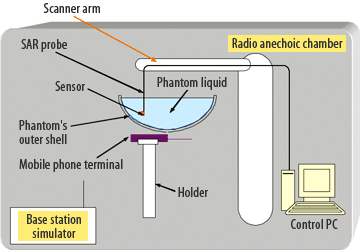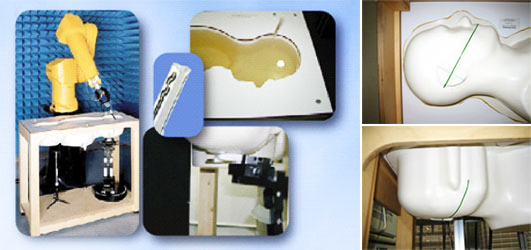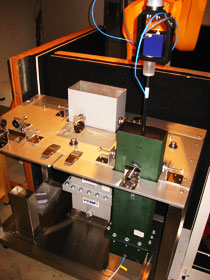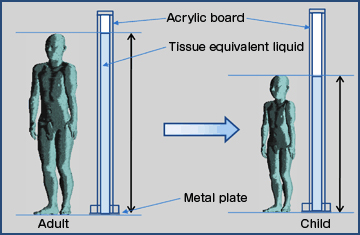Research is under way at NICT on technology to evaluate wireless devices’ compliance with radio frequency radiation protection guidelines (Compliance test). In particular, we have conducted uncertainty evaluations of head SAR measurement devices during use of UHF-band wireless terminals including mobile phones, and developed the SAR probes’ calibration devices. These activities have contributed to standardization of the compatibility evaluation methods.
When testing for compliance with radio frequency radiation protection guidelines in the VHF band, moreover, induced ankle currents must be evaluated as well. Therefore, we also carry out research on ways of measuring these types of currents.
Research on the SAR measurement and calibration methods
Since 2002, the law requires all mobile phones currently sold in Japan to undergo measurement of their Specific Absorption Rate (SAR), based on the radio frequency radiation protection guidelines. The devices are tested to see if they comply with the safety criteria set forth in these guidelines. Regarding the measurement of mobile phones’ SAR values, the following are rigorously stipulated under domestic and international standards.
- Measurement principles (SAR probes and phantom liquid)
- Phantom (shape and electrical constants)
- The position where the terminals are measured
Partial-body absorption guidelines:They apply to terminals such as mobile phones that are held close to the body when used. Local SAR per 10 g of any tissues must not exceed 2 W/kg (4 W/kg for extremities).
Measurement of SAR
SAR is measured by filling phantom liquid that has the same electrical properties as those of the human body in a container made in the shape of the human body, and scanning the inside using an SAR probe. In consideration of the situation in which the mobile phone is actually used, we conduct measurements under a variety of conditions, determine maximum SAR, and make evaluations. The SAR measurement system is comprised of the following three items.
- SAR probe
- Phantom
- SAR probe scanner
Place the terminal to be measured immediately below the phantom, and, while the radio waves are being emitted, measure the SAR inside the phantom.

Standard head model
A head phantom with a predetermined standard size and shape is used for measurement. The head phantom is filled with a liquid that has been adjusted to have dielectric constants (relative permittivity and electrical conductivity) equivalent to those of the human body. Since the dielectric constants of the phantom liquid also vary according to frequency, the composition of the liquid changes according to frequency. The dielectric constants of the phantom liquid are also stipulated, based on the standards.

Calibration of SAR probes
The probe must be calibrated to ensure precise SAR measurement. In calibrating the SAR probe, we first determine the calibration coefficient that relates the measured SAR to the output voltage or signal. The calibration system uses the theoretical value of the electric field inside a special waveguide tube to create the standard SAR. Because the dielectric properties of the phantom liquid differ according to frequency, calibration must be done for each frequency. * For NICT’s calibration operations, check here.

NICT’s approach
NICT conducts the research on uncertainty factors and increasing the accuracy of SAR measurement. We also pursue the research on SAR measurement techniques for new radio systems. Furthermore, NICT conducts the improvement of calibration methods for SAR probes and the development of calibration methods for new range of frequency that will be used for future mobile phones. Through these researches, we aim at establishing highly accurate and reliable SAR measurement techniques.
Research on the evaluation of compliance with radio frequency radiation protection guidelines in the VHF band
This research aims to develop human-body equivalent liquid antennas used for evaluating induced ankle currents in the evaluation of compliance with radio frequency radiation guidelines in the VHF band. In this frequency band, a phenomenon known as whole-body resonance occurs, or the human body acts as if it was a resonant antenna. Extremely strong electric currents are induced, especially in the ankles, when the human body is in the standing position on the ground. This results in significantly high local SAR in the ankles since electric current flows in a concentrated fashion in the ankle, which has a smaller cross-sectional area than other parts of the body.
Japan’s radio frequency radiation protection guidelines stipulate that the induced currents in the ankles, at frequencies between 30 MHz and 300 MHz, must be below 45 mA per leg.
NICT has been conducting research on a human-body equivalent antenna for use when measuring induced ankle currents. Using the human-body equivalent antenna to evaluate the induced ankle currents makes safety assessments possible without having to expose an actual human body directly to electromagnetic fields. By using the human-body equivalent liquid antenna that is being developed at NICT, the height of the liquid is adjusted to match the height of the human body, so the induced ankle currents can be measured in both adults and children. Saline solution is used as the liquid filled in this human-body equivalent antenna, since the dielectric constants can be changed quickly and easily, and because saline solution is often used as a tissue-equivalent liquid.


